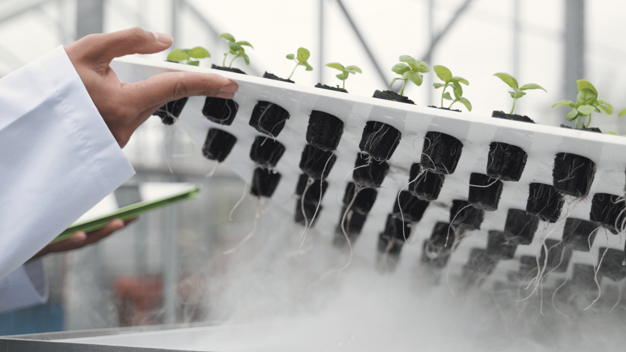The path of an innovative idea from its nascent stage into a commercially viable solution is a complex process full of challenges and opportunities. A prime example of this process can be seen in the Advanced Aeroponics project, a collaborative effort between LettUs Grow Ltd and Crop Health and Protection (CHAP).
This project demonstrates innovation in agri-tech but also serves as a valuable case study in navigating the path from conceptualization to commercial success.

The Problem
"Approximately 30% of the UK’s annual carbon emissions stem from our food system, and a key player in this environmental challenge is the import sector. In fact, for fruit and vegetables alone, the UK relies on imports for a staggering 84% of its annual fruit consumption and nearly 50% of its annual vegetable consumption. While UK growers grapple to match the cost-effectiveness of these imports throughout the year, their struggle intensifies during winter months when local production of fresh produce dwindles."
In response to these challenges, a collaboration was developed between CHAP and LettUs Grow. Combining the insights gathered from LettUs Grow’s Commercial Advisory Board with CHAP’s sector knowledge, a project was proposed to address the real-world challenges of the industry and improve the productivity, profitability, and sustainability of the UK’s fruit and vegetable supply chain.
The Genesis of an Idea
This project’s starting idea was to enhance greenhouse farming through ultrasonic aeroponics, a technology that suspends plant roots in the air, nourishing them with a nutrient-rich mist created using ultrasonic sound waves. This method promised several advantages over traditional methods, including higher crop yields, reduced water consumption, and decreased reliance on pesticides, setting the stage for a step forward in sustainable agriculture.
In taking this technology and developing it for the commercial greenhouse sector, a two-phase project was designed to develop and evaluate an Aeroponic Rolling Bench system before validating the technology through commercial growth trials.
From Research to Market
A significant challenge for the Advanced Aeroponics project was integrating the Aeroponic Rolling Bench system into existing greenhouse structures. This step was crucial in demonstrating the practicality and effectiveness of the innovation in real-world scenarios. In part one of the study, comprehensive initial trials at CHAP’s Vertical Farming Development Centre proved functionality across various crops with substantial growth rate improvements compared to standard hydroponic systems. The initial success provided proof of concept, with part two of the experimental phase focusing on the commercial viability and value at scale, plus fine-tuning for broader agricultural applications.
The trials conducted confirmed that this innovative approach could accelerate growth by an average 22% uplift in yield compared to hydroponic systems. Part two of the study focused on refining and scaling the Aeroponic Rolling Benches to fit the full commercial scale at which greenhouse growers operate, particularly those using automated systems to grow leafy green salads and herbs. This culminated in a small validation trial that reaffirmed the potential impact of this novel technology.
Looking Ahead
Introducing a new technology to the market requires more than just demonstrating its effectiveness. It involves educating potential users about the benefits and practicalities of the system, addressing any reservations, and providing robust support to facilitate adoption. As part of the project, key sector stakeholders were engaged through demonstration events hosted at CHAP’s Vertical Farming Development Centre and via industry trade events, creating solid foundations for the products’ future commercial launch.
This project’s success story is a testament to the potential of AgriTech innovations in transforming agricultural practices. It highlights the importance of persistent research, industry collaboration, and a deep understanding of market needs in turning an innovative idea into a commercially viable product. As the agricultural sector continues to face global challenges, such initiatives pave the way for more sustainable and efficient food production methods.
For more information:
CHAP
Email: [email protected]
https://chap-solutions.co.uk/
